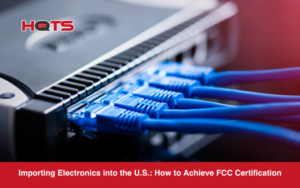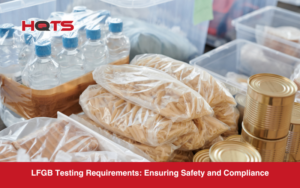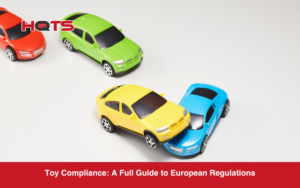When we talk about Food Contact Material testing (FCMs), most people would assume that we are talking about food packaging testing.
But from production to plate, our foods actually come into contact with many different surfaces and materials. Whether it’s plastic packaging, food containers, or even the tissue for your pizza slice at the restaurant, these materials all need to be safe.
In fact, between 2012 and 2017, the EU’s Rapid Alert System for Food and Feed (RASFF) got 507 notifications about FCMs, leading to import rejections or market recalls.
If that’s your product, that’s a big chunk of money that’s being lost in product recalls. It’s also easily avoided by understanding exactly which Food Contact Materials need to be tested.
Read on and we’ll break down exactly that.
Food Contact Materials (FCMs)

Food Contact Materials (FCMs) include anything that will come into contact with food, is already in contact with food, or has the potential to transfer substances into food. For example:
- Consumer packaging – bottles, cans, plastic containers, etc.
- Reusable items – food storage containers and kitchenware.
- Transport packaging – industrial drums and bulk containers.
- Production equipment – plastic, silicone, or rubber materials used during food processing.
Even though these materials serve different purposes, they all fall under the same regulations.
The rules also apply to raw materials and semi-finished products, not just final packaging. Food contact regulations focus on migration testing for food, not content. The focus is on how much substance transfers to the food from the packaging, not the total amount of substance present.
This is different from the REACH regulation.
Global Regulations and Compliance Standards (EU, FDA)
There are different regulations for FCMs around the world.
North America is the biggest market, covered by the FDA and boasting a huge food industry. In second place is Europe, also a major region with a mature testing ecosystem.
Both regions have different approaches to Food Contact Materials and migration testing for food. In this section we’ll break down the differences.
FDA Rules for FCM testing

If you’re making food packaging or anything that touches food, you need to follow FDA rules. The FDA has four main ways to check if a material is safe – let’s go through them one by one.
Title 21 of the Code of Federal Regulations (21 CFR)
One way is to follow Title 21 of the Code of Federal Regulations (21 CFR), Parts 170–199. If a material is listed in one of these sections and used as specified, it’s considered safe.
For example, plastics fall under Part 177, with polyethylene and polypropylene in Section 177.1520. Paper and cardboard are in Part 176, polymeric coatings in Part 175.300, and rubber articles in Section 177.2600. Companies need to make sure their materials are listed and pass required testing.
Generally Recognized as Safe (GRAS)
Another way is if the substance is Generally Recognized as Safe (GRAS). This means experts agree it’s safe, so no extra FDA approval is needed.
GRAS substances are listed in 21 CFR Parts 182, 184, and 186. Part 182 covers general GRAS substances, Part 184 includes direct food additives like salt and spices, and Part 186 covers indirect additives used in packaging. Companies must check the GRAS list and follow any restrictions.
Threshold of Regulation (TOR)
A third option is the Threshold of Regulation (TOR) exemption. If using a material results in exposure of less than 0.5 parts per billion (ppb), it may qualify for an exemption.
The FDA has a TOR database to check if a material is already approved. If it’s not listed, a company can request an exemption.
Food Contact Notification (FCN)
If a material isn’t covered under 21 CFR, GRAS, or TOR, companies can submit a Food Contact Notification (FCN) to the FDA. This means providing safety data, including migration testing and estimated dietary intake.
FCNs are specific to the company that submits them, so only that company can use the approved substance. For example, FCN 1605 covers octadecyl 3,5-di-tert-butyl-4-hydroxyhydrocinnamate, an antioxidant in polyurethane resins, but it can’t be used in contact with infant formula or human milk.
If a material isn’t covered by any of these, companies may need to submit their own FCN or TOR request. The FDA provides guidance in the document “Preparation of Pre-Market Submissions for Food Contact Substances: Chemistry Recommendations.”
To stay compliant, companies must confirm their materials are listed in 21 CFR, recognized as GRAS, qualify for a TOR exemption, or have an approved FCN. The FDA has online databases to check compliance. Following these rules ensures food packaging is safe and legal.

To learn more about Food Contact Material Testing, check out our free guide.
Food Contact Material compliance for the U.S.
If you want to sell food in the U.S., you need to follow FDA regulations to prove it’s safe. The first step is understanding what’s in your food and its packaging.
- Every ingredient and material that touches food must meet FDA standards. Some are already approved, like those listed under Generally Recognized as Safe (GRAS) or in Title 21 of the Code of Federal Regulations (21 CFR). If your ingredient isn’t on the list, you’ll need to show it’s safe before selling your product.
- If your packaging or processing equipment comes into contact with food, it also needs to meet FDA standards. Some materials are pre-approved, but if yours isn’t, you might need to submit a Food Contact Notification (FCN). This requires proving that it won’t release harmful chemicals into food. The FDA reviews these within 120 days, and if they don’t object, you can move forward.
- Every food product must meet the FDA’s “Reasonable Certainty of No Harm” standard, meaning it won’t pose health risks when used as intended. Food packaging testing may be needed to check if chemicals migrate from packaging into food or to confirm that the product is non-toxic.
Other agencies might also have a say. If your food contains meat, poultry, or eggs, you may need USDA approval. If it includes antimicrobial substances, the EPA could be involved too.
European rules for FCM testing

The EU framework includes two key regulations:
Regulation 1935/2004 – applies to all food contact materials (plastic, paper, glass, metal, etc.) and outlines several fundamental requirements. First, materials must not be toxic or pose any harm to human health. Additionally, they should not cause unacceptable changes in the composition of the food, and they must not affect the taste, smell, or overall quality of the food.
GMP Regulation 2023/2006 – The GMP Regulation ensures that food contact materials are made safely by requiring manufacturers to use appropriate raw materials, follow quality assurance measures, and maintain traceability. That means companies are responsible for product safety, with larger businesses facing stricter requirements than smaller ones.
These two regulations are called framework regulations because they cover all of the different materials and must be followed by every EU member state.
Underneath these two frameworks, there may also be additional laws called directives which apply to specific materials. Below we have outlined the key differences between regulations and directives.
FCM Regulations vs. Directives
A key difference in EU law:
- Regulations – Must be followed by all EU countries.
- Directives – Are implemented into national laws, leading to differences from country to country. This means with directives, each country can add stricter rules. For example, Austria adds antimony limits to ceramic laws and Norway includes cobalt restrictions.
This makes compliance trickier because the rules can vary between EU countries.
On top of this, some materials (like paper, inks, silicone, and adhesives) don’t have their own EU regulations but must still meet the two general safety framework regulations.
Food Contact Material Compliance for the EU
To demonstrate compliance with EU 10/2011 for plastics, all ingredients must be reviewed against the positive list, which includes approved monomers and additives with specific migration and residual content limits.
Compliance can be shown through migration modeling or lab testing. Migration modeling uses software to predict whether a substance will leach into food beyond legal limits. If the predicted migration levels are too high, the material must be physically tested in a lab.
Lab testing involves placing the material in contact with substances that mimic different types of food and measuring how much of any chemical transfers. The goal is to ensure that the material does not release harmful amounts of chemicals. The key tests include:
- Overall migration testing, which checks the total amount of substances that move from the material into food.
- Specific migration testing, which focuses on individual restricted substances, such as certain chemicals that might be harmful.
- Heavy metal testing, which ensures that toxic metals like lead and cadmium are not present at unsafe levels.
- Primary aromatic amine testing, which checks for harmful chemical residues.
- Color fastness testing, which ensures that dyes and pigments do not bleed into food.
- Sensory testing, which assesses whether the material affects the taste, smell, or appearance of the food.
To replicate real-life food storage and usage conditions, tests use different food simulants, which are liquids designed to behave like actual foods.
The total amount of substances that can migrate from the material into food is limited to 10 mg per square decimeter of material or 60 mg per kilogram of food. If the material passes all required tests, a Declaration of Compliance (DoC) can be issued. This document confirms that the material meets EU 10/2011 standards and is backed by lab test reports proving its safety.
Declaration of compliance
The Declaration of Compliance (DoC) is a mandatory document for manufacturers and importers of certain food contact materials in the EU. It is not to be confused with the Declaration of Conformity for CE-marked products. The DoC must be issued by manufacturers or importers to confirm compliance with relevant food contact regulations.
The document must include basic details such as the company name, product name, and a list of materials and components. For private label sellers, gathering this information may require direct coordination with the factory. Additionally, the DoC must include a compliance statement referencing applicable regulations. Since multiple regulations may apply depending on the material, thorough verification is essential.
The DoC must also contain details about substances used in the product, which can only be verified through third-party lab testing. It must specify the types of food or beverages the material is intended to contact, as well as time and temperature conditions. Furthermore, the document must include testing methods, which must be obtained from the laboratory conducting the analysis. Reliable labs like SGS, Intertek, and TÜV can provide this information.
Not all food contact materials require a DoC, but it is mandatory for plastic products like lunchboxes and food packaging. However, it also applies to composite materials (e.g., bamboo-melamine blends) and products with internal plastic components, such as stainless steel water bottles with plastic liners. Other factors, like coatings or paints, may also trigger the requirement.
A lab test report is necessary to issue a DoC, as compliance cannot be determined through assumptions. The report must confirm the absence of restricted substances such as lead or mercury. While EU-based manufacturers may provide a DoC, suppliers from platforms like Alibaba typically do not, meaning importers must ensure compliance independently.
Ensuring a valid DoC is crucial for meeting regulatory requirements and avoiding compliance issues when selling food contact materials in the EU.
FCM regulations in the EU and US – What are the differences?
Both the FDA (U.S.) and the EU use a self-declaration system, meaning companies must prove their materials comply with regulations.
There’s no official “FDA approval” or “EU approval.” Instead, companies show that their materials meet the legal requirements. To self-declare, companies need to review their material’s ingredients and, if necessary, conduct testing to confirm compliance.
What if a material isn’t approved?
- In the U.S: If a material isn’t already approved, a company can submit a Food Contact Notification (FCN) to request clearance.
- In the EU: If a material isn’t approved under EU regulations, a company can submit a petition to the European Food Safety Authority (EFSA) for evaluation.
Why testing Food Contact Materials is important
Food testing is an important part of the manufacturing process.
As food moves from the farm to our plate, it touches many different materials. That’s why it’s important to prevent chemicals and metals from leaking into our food.
Food contact material testing helps make sure that food is safe to eat by checking for any physical, chemical, or biological hazards.
HQTS: Complete support for Food Contact Material Testing
Testing food contact materials (FCM) can be a complicated process, but HQTS makes it easier.
We handle everything in-house—from lab testing to documentation—so you get accurate results and clear guidance without the extra hassle.
Our ISO/IEC 17025 accredited labs test for chemical migration, heavy metals, and other safety risks. We also help with sample collection, interpreting results, and ensuring compliance with FDA, EU and other regional regulations.
If something doesn’t meet the standards, we work with you to find a solution. Need reliable Food Contact Material Testing? Get in touch with HQTS now.




